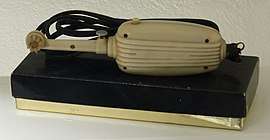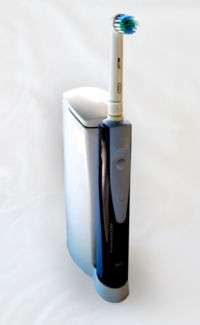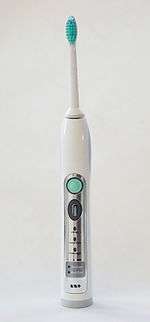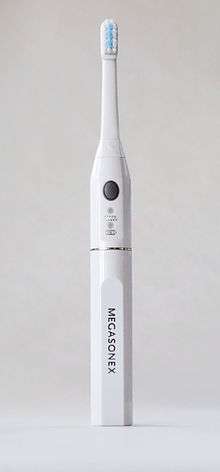Electric toothbrush
An electric toothbrush is a toothbrush that makes rapid automatic bristle motions, either back-and-forth oscillation or rotation-oscillation (where the brush head alternates clockwise and counterclockwise rotation), in order to clean teeth. Motions at sonic speeds or below are made by a motor. In the case of ultrasonic toothbrushes, ultrasonic motions are produced by a piezoelectric crystal. A modern electric toothbrush is usually powered by a rechargeable battery charged through inductive charging when the brush sits in the charging base between uses.
Electric toothbrushes can be classified according to the frequency (speed) of their movements as power, sonic or ultrasonic toothbrushes, depending on whether they make movements that are below, in or above the audible range (20–20,000 Hz or 2400–2,400,000 movements per minute), respectively.
History

The first electric toothbrush was produced by the Electro Massage Tooth Brush Company in the U.S.A. in 1927. In Switzerland in 1954 Dr. Philippe Guy Woog invented the Broxodent.[1] Woog's electric toothbrushes were originally manufactured in Switzerland (later in France) for Broxo S.A. The device plugged into a standard wall outlet and ran on line voltage. Electric toothbrushes were initially created for patients with limited motor skills and for orthodontic patients (such as those with braces).[2]
The Broxo Electric Toothbrush was introduced in the U.S. by E. R. Squibb and Sons Pharmaceuticals in 1960.[3] After introduction, it was marketed in the U.S. by Squibb under the names Broxo-Dent or Broxodent.[3] In the 1980s Squibb transferred distribution of the Broxodent line to the Somerset Labs division of Bristol-Myers Squibb.[4]
The General Electric automatic toothbrush was introduced in the early 1960s;[5] it was cordless with rechargeable NiCad batteries and although portable, was rather bulky, about the size of a two-D-cell flashlight handle.[6] NiCad batteries of this period suffered from the Memory effect. The GE Automatic Toothbrush came with a charging stand which held the hand piece upright; most units were kept in the charger, which is not the best way to get maximum service life from a NiCad battery. Also, early NiCad batteries tended to have a short lifespan. The batteries were sealed inside the GE device, and the whole unit had to be discarded when the batteries failed.
The use of an AC line voltage appliance in a bathroom environment was problematic. By the early 1990s Underwriter Laboratories (UL) and Canadian Standards Association (CSA) no longer certified line-voltage appliances for bathroom use. Newer appliances had to use a step-down transformer to operate the actual toothbrush at low voltage (typically 12, 16 or 24 volts). Wiring standards in many countries require that outlets in bath areas must be protected by a RCD/GFCI device (e.g., required in USA since the 1970s on bathroom outlets in new construction).
By the 1990s there were problems with safety certification of Broxo's original design. Further, improved battery-operated toothbrushes were providing formidable competition.
The first ultrasonic toothbrush, first called the Ultima and later the Ultrasonex, was patented in the U.S. in 1992, the same year the FDA gave it approval for daily home use. Initially, the Ultima worked only on ultrasound, but a few years later, a motor was added to give the Ultrasonex brush additional sonic vibration. Today, several ultrasonic toothbrushes simultaneously provide both ultrasound and sonic vibration.[7] In more modern times, electric toothbrushes have been used as a substitute for vibrators for those that wish to avoid embarrassment.[8]
Types

Electric brushes can be classified according to their type of action:
- Side to side vibration, which have a brush head action that moves laterally from side to side.
- Counter oscillation, indicates a brush action in which adjacent tufts of bristles (usually six to 10 in number) rotate in one direction and then the other, independently. Each tuft rotating in the opposite direction to that adjacent to it.
- Rotation oscillation, indicates a brush action in which the brush head rotates in one direction and then the other.
- Circular, indicates a brush action in which the brush head rotates in one direction only.
- Ultrasonic, indicates a brush action where the bristles vibrate at ultrasonic frequencies (> 20 kHz).
- Ionic, indicates a brush that aims to impart an electrical charge to the tooth surface with the intent of disrupting the attachment of dental plaque.[9]
For some vibrating toothbrush designs, a brushing technique similar to that used with a manual toothbrush is recommended, whereas with brushes with a spinning head the recommended cleaning technique is to simply move the brush slowly from tooth to tooth.[10]
Electric toothbrushes can also be classified according to the speed of their movements as standard power toothbrushes, sonic toothbrushes or ultrasonic toothbrushes. If the motion of the toothbrush is sufficiently rapid to produce a hum in the audible frequency of human range (20 Hz to 20,000 Hz), it can be classified as a sonic toothbrush. Any electric toothbrush with movement faster than this limit can be classified as an ultrasonic toothbrush. Certain ultrasonic toothbrushes, such as the Megasonex and the Ultreo, have both sonic and ultrasonic movements.[11]
Sonic toothbrush

Sonic toothbrushes are a subset of electric toothbrushes with movement that is fast enough to produce vibration in the audible range. Most modern rechargeable electric toothbrushes from brands such as Sonicare, FOREO, and Oral-B fall into this category and typically have frequencies that range from 200 to 400 Hz, that is 12,000–24,000 oscillations or 24,000–48,000 movements per minute. Because sonic toothbrushes rely on sweeping motion alone to clean the teeth, the movement that they provide is often high in amplitude, meaning that the length of the sweeping movements that they make is large.
Ultrasonic toothbrush

The newest developments in this field are ultrasonic toothbrushes, which use ultrasonic waves to clean the teeth. In order for a toothbrush to be considered "ultrasonic" it has to emit a wave at a minimum frequency of 20,000 Hz or 2,400,000 movements per minute. Typically, ultrasonic toothbrushes approved by the U.S. Food and Drug Administration (FDA) operate at a frequency of 1.6 MHz, which translates to 192,000,000 movements per minute.
Ultrasonic toothbrushes emit vibrations that are very high in frequency but low in amplitude. These vibrations break up bacterial chains that make up dental plaque and remove their methods of attachment to the tooth surface up to 5 mm below the gum line.[12]
Some ultrasonic toothbrushes, such as the Emmi-Dent, provide only ultrasonic motion. Other ultrasonic toothbrushes, such as the Ultreo and the Megasonex, provide additional sonic vibration ranging from 9,000 to 40,000 movements per minute, comparable to a sonic toothbrush, in order to provide additional sweeping motion which facilitates removal of food particles and bacterial chain remnants. The sonic vibration in these ultrasonic toothbrushes may be lower in amplitude than that found in a comparable sonic toothbrush because the bacterial chains do not need to be removed through sonic vibration, simply swept away, as they have already been broken up by the ultrasound.
Because of the similarity of the terms “ultrasonic” and “sonic”, there is some confusion in the marketplace and sonic toothbrushes are frequently mislabeled as ultrasonic ones. A toothbrush operating at a frequency or vibration of less than 2,400,000 movements per minute (20,000 Hz) is a "sonic" toothbrush. It is called "sonic" because its operating frequency, for example 31,000 movements per minute, is within the human hearing range of between roughly 20 Hz to about 20,000 Hz. Only a toothbrush that emits ultrasound, or vibration at a frequency greater than the upper limit of human hearing, can be called an "ultrasonic" toothbrush.
Effectiveness
Claims have been made that electric toothbrushes are more effective than manual ones as they are less dependent upon a user's personal brushing technique. Some dentists also claim that they help children with overcoming their fear of the dentist. Independent research finds that most electric toothbrushes are no more effective than manual brushes—assuming the manual toothbrush brush is used effectively.[13][14] The rotation-oscillation models have been found to be marginally better than manual ones, though of uncertain clinical importance.[13][15][16][17] The research concludes that the way brushing is done, including the amount of time spent, is more important than the choice of brush. For patients with limited manual dexterity or where difficulty exists in reaching rear teeth, however, dentists regard electric toothbrushes as being especially beneficial.[18] A 2014 Cochrane review suggested the effectiveness of electric toothbrushes over manual ones: plaque build-up and gingival inflammation was reduced by 11% and 6% respectively after one to three months of use and after three months of use, the reduction observed was greater – 21% reduction in plaque and 11% reduction in gingival inflammation.[19] In addition, ultrasound from a commercially available ultrasonic toothbrush has been shown to break up dental plaque composed of chains of cariogenic Streptococcus mutans bacteria, destroying their cell walls and removing their methods of attachment to the enamel surface, at a distance of 5mm from the plaque.[12]
The effectiveness of an electric toothbrush depends not only on its type of action and on correct use, but also on the condition of the brush head. Most manufacturers recommend that heads be changed every three to six months at minimum, or as soon as the brush head has visibly deteriorated.
Power source and charging
Modern electric toothbrushes run on low voltage, 12v or less. A few units use a step-down transformer to power the brush, but most use a battery, usually but not always rechargeable and non-replaceable, fitted inside the handle, which is hermetically sealed to prevent water damage. While early NiCd battery toothbrushes used metal tabs to connect with the charging base, some toothbrushes use inductive charging.
Environmental concerns
According to Friends of the Earth, "Disposable electric toothbrushes are one example of a terrible product ... it's virtually impossible to separate out the tech from the batteries and plastic casing which means valuable and often toxic materials are dumped in landfill or burnt in incinerators."[20]
Optional features
Timer
Many modern electric toothbrushes have a timer which buzzes, or briefly interrupts power, typically after two minutes, and sometimes every 30 seconds. This is associated with a customary recommendation to brush for two minutes, 30 seconds for each of the four quadrants of the mouth.
Display
Some electric toothbrushes have LCD screens which show brushing time and sometimes smiley face icons or other images to encourage optimal brushing. These features could encourage people to brush more accurately.[21][18]
Pressure sensor
Brushing teeth too hard causes enamel and gum damage. Most modern top-end sonic toothbrushes come with a pressure sensor, which prevents users from brushing too aggressively. There are two types of pressure sensors. Some sensors produce a sound warning and some immediately stop movements of the sonic toothbrush when it is used too aggressively.
Ultrasound indicator
Because of the fact that ultrasonic frequencies are beyond the audible range and the amplitude of movement emitted by an ultrasonic toothbrush is typically too small to be perceived, the ultrasound is imperceptible to humans and it may not be apparent that a brush running in pure ultrasound is turned on. Ultrasonic toothbrushes may include an indicator to notify the patient that ultrasound is being emitted.
Bluetooth
Bluetooth connectivity enables data to be transmitted from an electric toothbrush to another Bluetooth device, such as a smartphone. The brush can send data to an app, such as how long it has been brushing for and if too much pressure has been applied when brushing. The app can in turn send data back to the brush such as changing the cleaning modes available, and cleaning time. The sharing of data between toothbrush and smartphone is intended to assist the user in creating better brushing technique and habits. Electric toothbrush models that currently utilise Bluetooth include the Oral-B Pro 6000, Pro 6500, Pro 7000 and Genius 9000.
Cleaning modes
Most sonic toothbrushes come with different cleaning modes and intensity levels. Cleaning modes are designed for special types of cleaning efficiency. Some of the most well known are Sensitive, Daily care, Whitening and Tongue cleaning.
Certain toothbrushes that offer both ultrasonic and sonic motion allow for the intensity of the sonic motion to be reduced, or even for the sonic motion to be turned off entirely so that only ultrasound is emitted. Since ultrasound movements are very low in amplitude, this setting may be indicated for patients who may not be suitable candidates for typical sonic or power toothbrush vibration but need the additional cleaning power of an ultrasonic toothbrush, such as patients who have recently undergone periodontal surgery.
References
- Fridus van der Weijden; Dagmar Else Slot. "The effectiveness of toothbrushing". Dental Tribune. Retrieved 4 March 2015.
- Lee, Sean S. (2009). Breath : causes, diagnosis and treatment of oral malodor (2nd ed.). San Bernardino, CA: Culminare, Inc. p. 103. ISBN 978-1607259732. Retrieved 6 April 2017.
- "Who invented the toothbrush and when was it? (Everyday Mysteries: Fun Science Facts from the Library of Congress)". www.loc.gov. Retrieved 2017-11-24.
- "The leaders in Oral Health since 1956". BROXO. Retrieved 4 March 2015.
- Donald Webb (2006). Medical Meanderings. Lulu.com. p. 122. ISBN 978-1430301745. Retrieved 6 April 2017.
- "History of General Electric". General Electric. Retrieved 4 March 2015.
- Weebly, Corros. "Types of Electric Toothbrushes". gethealthyteeth.com. Retrieved 6 April 2017.
- Greening, [editors] Tom; Hobson, Dick (1980). Instant relief : the encyclopedia of self-help (1st Wideview Books ed.). [S.l.]: Wideview. p. 226. ISBN 978-0872235717.CS1 maint: extra text: authors list (link)
- Yaacob, Munirah; Worthington, Helen V; Deacon, Scott A; Deery, Chris; Walmsley, A Damien; Robinson, Peter G; Glenny, Anne-Marie (2014-06-17). "Powered versus manual toothbrushing for oral health". Cochrane Database of Systematic Reviews (6): CD002281. doi:10.1002/14651858.cd002281.pub3. ISSN 1465-1858. PMID 24934383.
- "Using A Rechargeable Electric Toothbrush" by Oral B
- "What is an ultrasound toothbrush". Wisegeek. Retrieved 4 March 2015.
- Shinada K, Hashizume L, Teraoka K, Kurosaki, N. Effect of ultrasonic toothbrush on Streptococcus mutans. Japan J. Conserv. Dent. 1999; 42 (2): 410–417.
- Yaacob M, Worthington HV, Deacon SA, Deery C, Walmsley AD, Robinson PG, Glenny AM (2014). "Powered versus manual toothbrushing for oral health". Cochrane Database Syst Rev (3): CD002281. doi:10.1002/14651858.CD002281.pub3. PMID 24934383. — Meta-analysis of studies of the effectiveness of electric toothbrushes
- Deery C, Heanue M, Deacon S, Robinson PG, Walmsley AD, Worthington H, Shaw W, Glenny AM (March 2004). "The effectiveness of manual versus powered toothbrushes for dental health: a systematic review". J Dent. 32 (3): 197–211. doi:10.1016/j.jdent.2003.11.006. PMID 15001285.
- "Thumbs down for electric toothbrush". BBC News. 21 January 2003.
- Penick C (2004). "Power toothbrushes: a critical review". Int J Dent Hyg. 2 (1): 40–4. doi:10.1111/j.1601-5037.2004.00048.x. PMID 16451451.
- Deacon, Scott A; Glenny, Anne-Marie; Deery, Chris; Robinson, Peter G; Heanue, Mike; Walmsley, A Damien; Shaw, William C (2010-12-08). "Cochrane Database of Systematic Reviews". Cochrane Database of Systematic Reviews (12): CD004971. doi:10.1002/14651858.cd004971.pub2. PMID 21154357.
- A dentist's perspective on the whether patients should be using electric or manual toothbrushes. Commentary Archived 2014-01-14 at the Wayback Machine — The Smile Team Balwyn North Dentist
- Yaacob M, Worthington HV, Deacon SA, Deery C, Walmsley AD, Robinson PG, Glenny AM (2014). "Powered versus manual toothbrushing for oral health". Cochrane Database Syst Rev. 6 (6): CD002281. doi:10.1002/14651858.CD002281.pub3. PMID 24934383.
- Kleinman, Zoe (2 March 2015). "Ikea unveils phone-charging furniture at MWC". BBC. Retrieved 2 March 2015.
- Dental and Oral Health (Adults) Don't Let a Disability Keep the Dentist Away — Daniel E. Jolly, Professor of Clinical Dentistry College of Dentistry The Ohio State University.